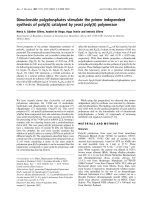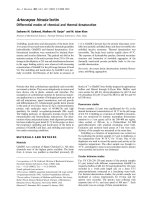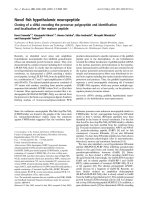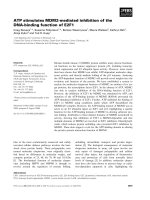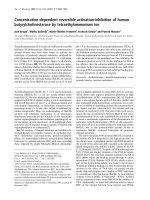Báo cáo y học: "Minimal instructions improve the performance of laypersons in the use of semiautomatic and automatic external defibrillator" pptx
Bạn đang xem bản rút gọn của tài liệu. Xem và tải ngay bản đầy đủ của tài liệu tại đây (196.37 KB, 7 trang )
Open Access
Available online />R110
April 2005 Vol 9 No 2
Research
Minimal instructions improve the performance of laypersons in
the use of semiautomatic and automatic external defibrillators
Stefan Beckers
1
, Michael Fries
1
, Johannes Bickenbach
1
, Matthias Derwall
2
, Ralf Kuhlen
3
and
Rolf Rossaint
4
1
Resident, Department of Anaesthesiology, University Hospital Aachen, Aachen, Germany
2
Medical Student, Department of Anaesthesiology, University Hospital Aachen, Aachen, Germany
3
Professor, Department of Anaesthesiology, University Hospital Aachen, Aachen, Germany
4
Professor and Chairman, Department of Anaesthesiology, University Hospital Aachen, Aachen, Germany
Corresponding author: Stefan Beckers,
Abstract
Introduction There is evidence that use of automated external defibrillators (AEDs) by laypersons
improves rates of survival from cardiac arrest, but there is no consensus on the optimal content and
duration of training for this purpose. In this study we examined the use of semiautomatic or automatic
AEDs by laypersons who had received no training (intuitive use) and the effects of minimal general
theoretical instructions on their performance.
Methods In a mock cardiac arrest scenario, 236 first year medical students who had not previously
attended any preclinical courses were evaluated in their first study week, before and after receiving
prespecified instructions (15 min) once. The primary end-point was the time to first shock for each time
point; secondary end-points were correct electrode pad positioning, safety of the procedure and the
subjective feelings of the students.
Results The mean time to shock for both AED types was 81.2 ± 19.2 s (range 45–178 s). Correct pad
placement was observed in 85.6% and adequate safety in 94.1%. The time to shock after instruction
decreased significantly to 56.8 ± 9.9 s (range 35–95 s; P ≤ 0.01), with correct electrode placement
in 92.8% and adequate safety in 97%. The students were significantly quicker at both evaluations using
the semiautomatic device than with the automatic AED (first evaluation: 77.5 ± 20.5 s versus 85.2 ±
17 s, P ≤ 0.01; second evaluation: 55 ± 10.3 s versus 59.6 ± 9.6 s, P ≤ 0.01).
Conclusion Untrained laypersons can use semiautomatic and automatic AEDs sufficiently quickly and
without instruction. After one use and minimal instructions, improvements in practical performance
were significant. All tested laypersons were able to deliver the first shock in under 1 min.
Keywords: automated external defibrillator, cardiopulmonary resuscitation, defibrillation, layperson, intuitive
Introduction
Mortality from sudden cardiac death is up to 375,000 patients
per year in Europe [1] and in the vast majority of cases it is
caused by ventricular fibrillation [2]. To increase survival rates,
the period between developing ventricular fibrillation and the
first defibrillation must be as short as possible. Early defibrilla-
tion, done during the first minute of the event, is successful in
85% of cases. Each additional minute without treatment
reduces the survival rate by a further 10% [3]. Therefore, early
defibrillation must be implemented into the chain of survival
[4], and to this end the development of programmes for non-
medical lay responders is recommended and supported by
many international societies. For years, the American Heart
Association has postulated inclusion of AED use in basic life
Received: 14 September 2004
Revisions requested: 13 October 2004
Revisions received: 1 November 2004
Accepted: 30 November 2004
Published: 31 January 2005
Critical Care 2005, 9:R110-R116 (DOI 10.1186/cc3033)
This article is online at: />© 2005 Beckers et al.; licensee BioMed Central Ltd.
This is an Open Access article distributed under the terms of the
Creative Commons Attribution License ( />licenses/by/2.0), which permits unrestricted use, distribution, and
reproduction in any medium, provided the original work is cited.
AED = automated external defibrillator; BLS = basic life support; PAD = public access defibrillation.
Critical Care April 2005 Vol 9 No 2 Beckers et al.
R111
support (BLS) training [4,5]. Furthermore, first responders
may operate an AED without having any background knowl-
edge about the instrument. Previous studies have shown that
even children can handle an AED confidently and effectively
[6].
There is no consensus as yet regarding time frames for spe-
cific training programmes, but for organizational reasons and
for further implementation of public access defibrillation (PAD)
programmes in the future, it is necessary that this period be
defined. It remains unclear how lay users should be instructed
to perform safe and effective defibrillation. The aim of the
present study was to evaluate the intuitive use (i.e. without
training) of AEDs, both in fully automatic and in semiautomatic
modes, and to study the effect of brief and well directed theo-
retical instruction.
Methods
Participants
A total of 236 first year medical students were tested during
their first 2 weeks at the medical school of the University of
Aachen. All students were informed that their performance
would be evaluated and used for scientific study. No personal
data were collected. Furthermore, no damage to anyone's
health was anticipated because the AED uses no current.
Therefore, the institutional ethical committee waived the need
to obtain informed consent from each participant. None of the
students were prompted or prepared in any way before the
study.
Equipment
The Medtronic Physio-Control LifePak™ CR-T AED trainer
(Medtronic Physio-Control LifePak™; Medtronic, Düsseldorf,
Germany) provides the necessary interface for demonstrating
practical skills during a simulated cardiac arrest, and was used
rather than the original Medtronic Physio-Control LifePak™ CR
Plus. No current is applied by the training device.
After opening the lid a red handle must be pulled, which then
releases self-adhesive electrode pads with integrated cables
connected to the device (Fig. 1). Voice prompts (Table 1) and
an illustrated reference card inside the opened lid guides
users in a step-by-step manner. No text prompts are displayed
on the screen. After turning the device on and positioning the
electrodes properly, the analyzing process of the AED starts
automatically and is finished after 10 s in both types of AED.
In the semiautomatic mode it takes 18 s from the beginning of
the analyzing process until the device is charged, and an alarm
tone sounds until the shock button is pressed. In the automatic
mode the shock is delivered automatically after 21 s and the
charge is calculated from the analysis of heart rhythm over this
period [7].
Study protocol
In a mock cardiac arrest scenario, the students were evaluated
on a manikin (ResusciAnne
®
; Laerdal, Stavanger, Norway).
After randomization, 118 students were tested on an AED in
automatic mode, and 118 were tested on a semiautomatic
AED. The device was kept in its usual standby mode. The man-
ikin was positioned supine and dressed in a zippered jacket.
Three physicians skilled in providing and teaching advanced
life support (certified instructors of the European Resuscita-
tion Council) were present and recorded data while each stu-
dent operated the AED. Each student was tested individually
and was unable to observe the performance of other partici-
pants. They were read the following text: 'This patient is uncon-
scious, not breathing and has no signs of circulation. The
device in front of you may help to restore spontaneous
circulation.'
The procedure ended when the first shock was delivered or no
shock could be given in 240 s. Placement of the electrode
pads was accepted as correct if the left pad covered at least
50% of an area circumscribed by the nipple line superiorly,
costal margin inferiorly, mid-clavicular line medially and mid-
axillary line laterally. The right pad was required to cover at
least 50% of an area circumscribed by the clavicle superiorly,
nipple line inferiorly, anterior axillary line laterally and right ster-
nal margin medially. Application of the AED was considered to
be safe if the student remained clear of the manikin during
delivery of the shock. If a technical problem occurred, the stu-
dent damaged the AED, started with conventional cardiopul-
monary resuscitation, or had language difficulties, then this
was classified as 'any other problem'.
After having completed the tests, each student completed a
standardized questionnaire to evaluate whether they had any
Figure 1
Evaluated automated external defibrillator: (left) automatic mode and (right) semiautomatic modeEvaluated automated external defibrillator: (left) automatic mode and
(right) semiautomatic mode. Weight: 2.1 kg; physical dimensions: 10 ×
20 × 24 cm.
Available online />R112
experience with an AED before the study or whether they had
any medical education (e.g. nurse, paramedic etc.). After a
period of 1 week all test candidates were assigned the same
type of device they had used in their first test and were re-eval-
uated in the same scenario. During this week they attended a
short lecture (15 min) emphasizing the following core objec-
tives: importance of sudden cardiac death and of defibrillation
in this context; importance of 'time to shock' to return of spon-
taneous circulation and success of resuscitation over time;
importance of correct electrode pad positioning; safety
aspects when using an AED; general procedure for defibrilla-
tion devices (e.g. analysis, voice prompts); general AED algo-
rithm following guidelines; and special instructions for slim and
overweight victims.
There were no practical training sessions available between
the two evaluations and no specific information on the tested
AED devices was given.
Data analysis
Data are expressed as means ± standard deviation. P ≤ 0.05
was considered statistically significant. Statistical software
SPSS version 11.0 (SPSS Inc., Chicago, IL, USA) was used.
Primary end-points
The primary end-point was to determine the time from the
beginning of the scenario to first shock. Using a t-test, differ-
ences in time to shock between the first and second evalua-
tions were calculated, as well as between the semiautomatic
and the automatic devices for each time point.
Secondary end-points
The secondary end-points were chosen to assess correct
electrode pad positioning and the safety of the procedure, as
well as previous medical knowledge. Data were compared in
a proportional manner and tested for significant differences
using the McNemar test.
Table 1
Voice prompts of the automated external defibrillator during the simulated cardiac arrest scenario
Automatic Semiautomatic Tones
Call for help now After the AED lid opens, two beeping tones sound. The voice
prompts will sound following the beeping tones
Remove clothing from chest
Pull red handle to open bag
Peel each pad off blue plastic
Apply pads to exposed chest
Do not touch patient – evaluating heart rhythm Two beeping tones sound to simulate heart rhythm analysis
Stand by – preparing to shock
Everyone clear
Press flashing button Semiautomatic model only; an alarm tone sounds until the
shock button is pressed
Do not touch patient – delivering shock Automatic model only; an alarm tone sounds until shock is
delivered automatically
Shock delivered
Voice prompts that are not used
No shock advised
Shock not delivered
Check for pulse; if no pulse start CPR
Check for breathing; if not breathing start CPR
Check for signs of circulation; if no signs of circulation start CPR
Continue care
Check pads for good contact
Motion detected
Stop motion
AED, automated external defibrillator; CPR, cardiopulmonary resuscitation. Data from Medtronic [7].
Critical Care April 2005 Vol 9 No 2 Beckers et al.
R113
Results
The mean age of the study population was 20.7 ± 2.9 years
(range 18–42 years). Of the 236 students included, 28
(11.9%) had a history of medical education (16 emergency
medicine technicians and paramedics, and 12 nurses).
Time to defibrillation, electrode pad positioning and
safety
In the first evaluation the time to shock for both devices was
81.2 ± 19.2 s (range 45–178 s). The pads were positioned
correctly by 85.6% of the students. Shock was administered
safely by 94.1%. In the second evaluation the time to first defi-
brillation decreased significantly to 56.8 ± 9.9 s (range 35–95
s; P ≤ 0.01). The electrodes were correctly placed in 92.8%
of cases, and shock was administered safely in 97% of cases.
Table 2 summarizes these variables by type of AED. When
comparing time to first shock between semiautomatic and
automatic AEDs, the students were significantly faster in both
evaluations using the semiautomatic device (first evaluation:
77.5 ± 20.5 s versus 85.2 ± 17 s, P ≤ 0.01; second evalua-
tion: 55 ± 10.3 s versus 59.6 ± 9.6 s, P ≤ 0.01).
In the second evaluation 113 out of 118 (95.8%) students
were able to deliver a shock safely and none failed in the sem-
iautomatic group. In the automatic group 115 of 118 (97.5%)
were able to deliver a shock, but three students failed.
Students with pre-existing medical education were significant
faster at both times (first evaluation: 73.0 ± 17.1 s versus 83.0
± 19.1 s, P ≤ 0.01; second evaluation: 51.8 ± 9.2 s versus
58.3 ± 10.1 s, P ≤ 0.01). All other findings are summarized in
Table 2.
Discussion
This study represents the first comparison in laypersons of the
use of fully automatic devices with that of semiautomatic
devices, including the largest study group yet reported. The
improvements with both devices, in terms of time to first shock,
between initial use without instruction and use following the
described 15-min theoretical instruction were significant.
Since the first clinical use of AEDs in the early 1980s [8],
developments in technology have led to initiatives by health
and governmental organizations to develop PAD programmes
[9]. Various studies [10-13] have shown improvements in
rates of survival from out-of-hospital cardiac arrest where non-
medical personnel were trained in PAD programmes. How-
ever, only a few studies described the performance of
laypersons, but even these individuals were initially instructed
before evaluation [6,14]. In a cross-over design, Eames and
Table 2
Time to first shock, correct electrode pad positioning and safety aspects before and after brief general instruction in defibrillation
Device
Semiautomatic Automatic
n 118 118
Age (mean ± SD) 21.1 ± 3.3 20.4 ± 2.3
Male (n [%]) 45 (38.1%) 38 (32.2%)
First evaluation
Time to shock (s; mean ± SD) 77 ± 20.4*
†
85 ± 17.2
†
Not able to deliver shock (n [%]) 6 (5.1%)
‡
4 (3.4%)
Incorrect pad positioning (n [%]) 15 (12.7%) 19 (16.1%)
‡
Safe shock (n [%]) 109 (92.4%) 113 (95.8%)
Any other problems
a
(n [%]) 18 (15.3%) 12 (10.2%)
Second evaluation
Time to shock (s; mean ± SD) 55 ± 10.3* 59 ± 9.1
Not able to deliver shock (n [%]) 0 (0%) 3 (2.5%)
Incorrect pad positioning (n [%]) 11 (9.3%) 3 (2.5%)
Safe shock (n [%]) 113 (95.8%) 115 (97.5%)
Any other problems
a
(n [%]) 3 (2.5%) 2 (1.7%)
Comparison of subjects using semiautomatic and automatic devices at different evaluations.
a
Any other problems as described in the study
protocol. *P < 0.05, versus automatic device (t-test).
†
P < 0.05, versus second evaluation (t-test).
‡
P < 0.05, versus second evaluation (McNemar
test). SD, standard deviation.
Available online />R114
coworkers [15] compared the use of three different AEDs by
nearly untrained laypersons (n = 24), but information had been
given concerning the application of a shock, following instruc-
tions for the device and the impact that time to defibrillation
has on outcome. To our knowledge, the present study is the
first to describe the use of AEDs without any instructions
before first use. It is noteworthy that, even without instruction,
226 out of 236 participants (95.8%) were able to deliver a
shock.
Safety aspects associated with automatic mode have been
considered and critically discussed, but the question of
whether it is better not to administer an advised shock in the
case of proven ventricular fibrillation or to have a shock deliv-
ered automatically with a delay is rhetorical. Surveying safety
aspects of the tested AED, we found that 92.4% of students
were able to deliver a shock safely in semiautomatic mode and
95.8% in automatic mode during testing without prior instruc-
tion. After theoretical instruction, these rates increased to
95.8% and 97.5%, respectively. Eames and coworkers [15]
found that all individuals stood clear while delivering the shock
but, as mentioned above, only 24 subjects were tested; it fol-
lows that possible reluctance to adhere to safety procedures
might not have been detected in that investigation. Fromm and
Varon [16] found that still 10 months after initial training, the
'simplicity of use of the particular AED' was the core issue
determining safety. The important benefit of devices pro-
grammed in automatic mode is that they relieve the layperson
of decision making in an unfamiliar and stressful situation.
Contrary to expectations were our findings regarding elec-
trode pad placement. There was an anticipated and significant
improvement in the automatic group, but only a trend was
observed in the semiautomatic group. It is inexplicable why,
after instruction, 9.3% (11 students) still could not achieve
correct pad positioning. This is in contrast to the study by Gun-
dry and coworkers [6], in which all children were able to posi-
tion the pad in the required area, whereas Eames and
coworkers [15] observed 20.9% incorrect electrode place-
ment with the LifePak CR Plus. With the Philips/Laerdal
Heartstart1 the result was only 4.2%, and the Zoll AEDPlus
had the worst result, with 41.6% incorrect pad positioning. In
some cases, confusing descriptions or drawings might have
caused the incorrect positioning of the adhesive pad elec-
trodes in the present study. Overall, this supports the conclu-
sion of Eames and coworkers that simple devices should be
developed with clear visual instructions, and it reiterates that
design, construction and visual aids have an impact on user
performance. This statement was confirmed by our observa-
tion that even in the second evaluation, in the automatic group
three students were unable to deliver a shock. In these three
cases the students were confused by the voice prompts of the
automatic device, and while trying to push the shock button
they turned the device off. Other detected problems in both
testing sessions occurred mainly as a result of language prob-
lems, but they were reduced after instruction. In general, none
of the participants appeared to be apprehensive about operat-
ing the AED because none of them refused to participate in
the study or to apply the device to the manikin.
The significant difference in time to shock before and after
instruction between semiautomatic AED and the automatic
device is a possible effect of the software version used. How-
ever, the programmed delay of 3 s to delivery of shock in the
automatic device does not adequately explain this finding.
Changing the timing of voice prompts and development of
clearer instructions may lead to different results. In general,
however, the voice prompts that lead to the best results
remains a matter for discussion.
The studies published thus far led to the statement from the
American Heart Association and the Resuscitation Council UK
'not to specify the nature of content or duration of BLS plus
AED programs due to the lack of current evidence on which to
base any such guidance' [17]. As yet there is no consensus
regarding the optimal duration of specific training pro-
grammes. It will be difficult to achieve that perfect perform-
ance of certain skills that indicates successful training of
laypersons. Especially for organizational reasons, it is funda-
mental to define time frames of course concepts. We endorse
the assertion by Gundry and coworkers [6] and Moule and
Albarran [17] that simplified training programmes should be
developed, exploiting the potential of multimedia technology,
along with adequate teaching and learning materials.
Various concepts have been described [10,11,17-21], but no
data exist regarding how best to train and what the optimal
duration of training is to achieve the best outcomes. Moule and
Albarran [17] recently stated that the duration and most effec-
tive methods for teaching professionals and laypersons remain
undefined. For this reason, no recommendation can yet be
given. The implementation of PAD programmes in the future
will depend mainly on the willingness of the public to partici-
pate in AED or cardiopulmonary resuscitation courses. The
more time required to achieve the necessary skills, the less
people will feel able to participate voluntarily. Furthermore,
training sessions must be as precise and short as possible for
organizational reasons; ideally, it should be possible for even a
small number of instructors to reach a large group of trainees
in minimal time.
Limitations of the study
The groups evaluated here are not representative of the gen-
eral population with respect to sex (male 35% [n = 83], female
65% [n = 153]) and age, but the two groups are comparable
(Table 2). In addition, the students were not chosen by ran-
dom; nevertheless, they do represent young and inexperi-
enced laypersons with respect to medical issues because, in
Germany, students begin medical school directly after gradu-
ation from secondary school, without any specific preparation.
Critical Care April 2005 Vol 9 No 2 Beckers et al.
R115
As considered by other studies [16,22], the participants might
not have been free from external or internal motivations
because of the fact that they were going into medicine. How-
ever, at this stage they are at best minimally trained and are not
representative of the health care professional community. Fur-
thermore, this internal motivation could have influenced their
knowledge of theoretical issues concerning defibrillation
within the evaluation period, but it is unlikely that there would
have been a significant improvement in practical performance
after, for instance, a web search.
Finally, no manikin used to represent an unconscious, breath-
less and pulseless victim can simulate a human perfectly.
Because of this limitation, it is debatable whether benefits
obtained in a simulated representation of a complex situation
can be realized in clinical practice.
Conclusions
Untrained laypersons are able to use AEDs quickly and safely.
The observation that measures of practical performance (i.e.
time to first shock, accuracy of electrode pad placement and
safety) were significantly improved after minimal theoretical
instruction and one use, but without technical instructions in
the use of the specific device, is supportive of widespread
implementation of PAD programmes wherever possible. More-
over, enhanced acceptance of AEDs and the increased likeli-
hood that AEDs will be used following directed 'public
information' (e.g. television campaigns or other extensive pub-
licly available media) is of great importance. Core issues (e.g.
the significance of sudden cardiac death and the importance
of defibrillation in this context) should be at the forefront of
new educational changes; some suggestions in this regard
were made in the present study.
Taken together, our findings support previous recommenda-
tions to develop features that can be made available in all
AEDs. Sophisticated devices with simple instructions – visual
or vocal – should be implemented in PAD programmes. Fur-
ther developments should aim at simplifying the application of
electrodes and achieving consistency in the instructions given
by the different manufacturers. Value must be attached to giv-
ing general instructions and information about features that
are common to all devices; describing the specific details of a
device does not appear to be essential, as was assumed.
In our opinion, one of the most remarkable findings is that all
tested laypersons were able to deliver a shock in less than 1
min after minimal instructions had been given, regardless of
whether automatic or semiautomatic mode was used. Despite
the limitations of the study, we conclude that only minimal
background knowledge is needed for laypersons to use an
AED safely and quickly, and that further implementation of
AEDs for use by minimally trained persons without any medical
training is possible. We believe that keeping instructions for
laypersons as simple as possible will lead to greater accept-
ance and motivation, and will further facilitate PAD pro-
grammes. Time spent training to acquire necessary
cardiopulmonary resuscitation skills within the BLS algorithm
can be saved by focusing AED instructions in this way. Further
studies are warranted to determine whether skills are retained
over the long term.
Competing interests
The author(s) declare that they have no competing interests.
Authors' contributions
SB had conceived the study. SB, MF, JB, RK and RR designed
the study protocol. Testing was performed by SB, MF, JB and
MD. Statistical analysis was done by MF and MD. SB, MF, JB,
RK and RR wrote and reviewed the manuscript before submis-
sion. All authors read and approved the final manuscript.
Acknowledgements
We thank all first year students of the medical faculty, University Aachen,
Germany, for participating in this study and Medtronic Physio-Control
Germany Corp for loaning the AED trainer and electrode pads to the
investigators of the study.
Part of this work was presented at the 24th International Symposium on
Intensive Care and Emergency Medicine (ISICEM), Brussel, Belgium;
30 March 30 2004 [23].
References
1. The Hypothermia After Cardiac Arrest Study Group: Mild thera-
peutic hypothermia to improve the neurological outcome after
cardiac arrest. N Engl J Med 2002, 346:549-556.
2. Weaver DW: Considerations for improving survival from out-
of-hospital cardiac arrest. Ann Emerg Med 1986,
15:1181-1186.
3. Advanced Life Support Working Party of the ERC: Guidelines for
adult advanced cardiac life support. Resuscitation 1992,
24:111-121.
4. The American Heart Association in collaboration with the Interna-
tional Liaison Committee on Resuscitation: Part 4: the automated
external defibrillator: key link in the chain of survival. European
Resuscitation Council. Resuscitation 2000, 46:73-91.
5. The American Heart Association in collaboration with the Interna-
tional Liaison Committee on Resuscitation: Guidelines 2000 for
Cardiopulmonary Resuscitation and Emergency Cardiovascu-
Key messages
• This first observation in 'fully' automatic devices con-
firms that this type of AED can be used safely and effec-
tively by lay responders.
• All tested laypersons were able to deliver a shock in
less than 1 min after minimal instructions, regardless of
whether automatic or semiautomatic mode was used.
• In future value must be attached to general instruction
and similarities; describing specific details of available
devices is not essential.
• Previous recommendations to develop features that can
be made available in all AEDs are supported by our
findings.
Available online />R116
lar Care. An international consensus on science. Circulation
2000, 102:1-384.
6. Gundry JW, Comess KA, DeRook FA, Jorgenson D, Bardy GH:
Comparison of naive sixth-grade children with trained profes-
sionals in the use of an automated external defibrillator. Circu-
lation 1999, 100:1703-1707.
7. Medtronic Physio-Control LifePak Corp: . In RU. LifePak CR-T
AED-Trainer Operating Instructions Minneapolis, MN: Medtronic
Physio-Control LifePak Corp; 2002.
8. Weaver DW, Copass MK, Hill DL, Fahrenbruch C, Hallstrom AP,
Cobb LA: Cardiac arrest treated with a new automatic external
defibrillator by out-of-hospital first responders. Am J Cardiol
1986, 57:1017-1021.
9. Davies CS, Colquhoun M, Graham S, Evans T, Chamberlain D:
Defibrillators in public places: introduction of a national
scheme for public access defibrillation in England. Resuscita-
tion 2002, 52:13-21.
10. Page RL, Joglar JA, Kowal RC, Zagrodzky JD, Nelson LL, Ramas-
wamy K, Barbera SJ, Hamdan MH, McKenas DK: Use of auto-
mated external defibrillators by a U.S. airline. N Engl J Med
2000, 343:1210-1216.
11. Valenzuela TD, Roe DJ, Nichol G, Clark LL, Spaite DW, Hardman
RG: Outcomes of rapid defibrillation by security officers after
cardiac arrest in casinos. N Engl J Med 2000, 343:1206-1209.
12. White RD, Asplin BR, Bugliosi TF, Hankins DG: High discharge
survival rate after out-of-hospital ventricular fibrillation with
rapid defibrillation by police and paramedics. Ann Emerg Med
1996, 28:480-485.
13. Ross P, Nolan J, Hill E, Dawson J, Whimster F, Skinner D: The use
of AEDs by police officers in the City of London. Automated
external defibrillators. Resuscitation 2001, 50:141-146.
14. Moore JE, Eisenberg MS, Cummins RO, Hallstrom A, Litwin P,
Carter W: Lay person use of automatic external defibrillation.
Ann Emerg Med 1987, 16:669-672.
15. Eames P, Larsen PD, Galletly DC: Comparison of ease of use of
three automated external defibrillators by untrained lay
people. Resuscitation 2003, 58:25-30.
16. Fromm RE Jr, Varon J: Automated external versus blind manual
defibrillation by untrained lay rescuers. Resuscitation 1997,
33:219-221.
17. Moule P, Albarran JW: Automated external defibrillation as part
BLS: implications for education and practice. Resuscitation
2002, 54:223-230.
18. White RD, Vukow L, Buglosi T: Early defibrillation by police: ini-
tial experience with measurement with time intervals and
patient outcome. Ann Emerg Med 1994, 23:1009-1013.
19. Stults KR, Brown D, Schug V, Bean JA: Prehospital defibrillation
performed by emergency medical technicians in rural
communities. N Engl J Med 1984, 310:219-223.
20. Stults KR, Brown DD, Kerber RE: Efficacy of an automated
external defibrillator in the management of out-of-hospital
cardiac arrest: validation of the diagnostic algorithm and initial
clinical experience in a rural environment. Circulation 1986,
73:701-709.
21. Mols P, Beaucarne E, Bruyninx J, Labruyere JP, De Myttenaere L,
Naeije N, Watteeuw G, Verset D, Flamand JP: Early defibrillation
by EMTs: the Brussels experience. Resuscitation 1994,
27:129-136.
22. Domanovits H, Meron G, Sterz F, Kofler J, Oschatz E, Holzer M,
Mullner M, Laggner AN: Successful automatic external opera-
tion by people trained only in basic life support in a simulated
cardiac arrest situation. Resuscitation 1998, 38:47-50.
23. Beckers S, Fries M, Bickenbach J, Derwall M, Kuhlen R, Rossaint
R: Comparison of automatic vs semiautomatic automated
external defibrillators used by laypersons [abstract]. Critical
Care 2004:P293.

